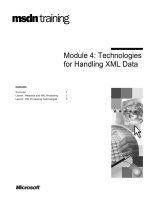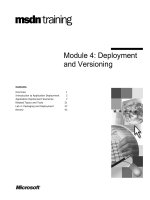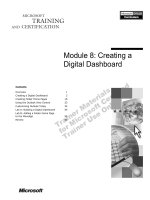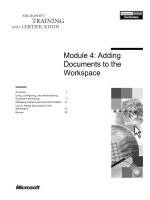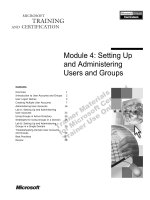Tài liệu Module 4: Designing a User Data Management Strategy pptx
Bạn đang xem bản rút gọn của tài liệu. Xem và tải ngay bản đầy đủ của tài liệu tại đây (1.18 MB, 48 trang )
Contents
Overview 1
Determining Current User Data Strategies 2
Determining the Organizational
Requirements 7
Categorizing User Data Management Needs 9
Identifying Available User Data
Management Options 15
Selecting Appropriate User Data Options 28
Lab A: Meeting User Data Management
Requirements 33
Review 40
Module 4: Designing a
User Data Management
Strategy
Information in this document, including URL and other Internet Web site references, is subject to
change without notice. Unless otherwise noted, the example companies, organizations, products,
domain names, e-mail addresses, logos, people, places, and events depicted herein are fictitious,
and no association with any real company, organization, product, domain name, e-mail address,
logo, person, places or events is intended or should be inferred. Complying with all applicable
copyright laws is the responsibility of the user. Without limiting the rights under copyright, no
part of this document may be reproduced, stored in or introduced into a retrieval system, or
transmitted in any form or by any means (electronic, mechanical, photocopying, recording, or
otherwise), or for any purpose, without the express written permission of Microsoft Corporation.
Microsoft may have patents, patent applications, trademarks, copyrights, or other intellectual
property rights covering subject matter in this document. Except as expressly provided in any
written license agreement from Microsoft, the furnishing of this document does not give you any
license to these patents, trademarks, copyrights, or other intellectual property.
2001 Microsoft Corporation. All rights reserved.
Microsoft, MS-DOS, Windows, Windows NT, Active Desktop, Active Directory, IntelliMirror,
Outlook, PowerPoint, and Visio are either registered trademarks or trademarks of Microsoft
Corporation in the U.S.A. and/or other countries.
The names of actual companies and products mentioned herein may be the trademarks of their
respective owners.
Module 4: Designing a User Data Management Strategy iii
Instructor Notes
In this module, students will examine the current user data management
methods and future requirements. After students determine these methods and
needs, they can identify the most appropriate technologies to address those
needs and to include in a user data management plan.
After completing this module, students will be able to:
Determine an organization’s current strategy for user data.
Determine the organizational requirements for user data.
Categorize user data management needs.
Identify available user data management options.
Select the appropriate options that would meet the organization’s needs.
Materials and Preparation
This section provides the materials and preparation tasks that you need to teach
this module.
Required Materials
To teach this module, you need the following materials:
Microsoft
®
PowerPoint
®
file 2410a_04.ppt
Module 4, “Designing a User Data Management Strategy”
Trainer Materials compact disc
Preparation Tasks
To prepare for this module:
Read all of the materials for this module.
Read the technical white papers located on the Trainer Materials compact
disc.
Read any relevant information in the Microsoft Windows
®
2000 or
Microsoft Windows XP Help files, and in the Windows 2000 or
Windows XP Resource Kit.
Familiarize yourself with the principles and practice of Change and
Configuration Management (CCM).
Read the instructor notes that precede each module. These contain
preparation suggestions for each module.
Read the review questions and be prepared to elaborate on the answers
provided in the text.
Complete the lab and be prepared to elaborate on the solutions found there.
Presentation:
90 Minutes
Lab:
30 Minutes
iv Module 4: Designing a User Data Management Strategy
Module Strategy
Use the following strategy to present this module:
Determining Current User Data Strategies
In this section, students learn how to gather the information that is required
for the analysis of the current user data management environment. In
addition, students learn how to assess the organization’s current methods
and technologies used for managing user data. Take the following actions:
• Emphasize that each user will have different types of information—each
group will have different amounts of office documents, e-mail, database
information, and data relating to custom applications. It is not always
easy to establish where the information resides and, perhaps more
importantly, what the impact would be if the information were lost or
damaged.
• Establish that a backup strategy is only as good as the recovery
procedures. There may be minimal gain in taking backups because
information is difficult to recover (for administrative or technical
reasons). Discuss anecdotal cases in which recovery procedures were
never tested, and when recovery was finally required, it was discovered
that backups had never been working.
Determining the Organizational Requirements
In this section, students learn how to identify the organization’s needs for
the management of user data and to address those needs in a plan for user
data management.
It is difficult to determine exact storage requirements. Recognize that
storage needs inevitably increase over time.
Categorizing User Data Management Needs
In this section, students learn how to classify users’ computing needs
according to job requirements and location. Students also determine how to
combine these categories with any organizational considerations to create
standard configurations.
Different user types have varying user data needs. For example, mobile
workers require secure access to their data, mostly during office hours,
whereas some workers may need access during the evening or 24 hours a
day.
Module 4: Designing a User Data Management Strategy v
Identifying Available User Data Management Options
In this section, students identify several different technologies available for
the management of user data in an organization and assess their suitability
to organizational requirements.
The main technologies for user data management have been introduced
already. In this section, you describe the application of such technologies.
Do not go into too much technical detail, unless prompted to do so.
Selecting Appropriate User Data Options
In this section, students define which features will be used for Change and
Configuration Management to address the user data management needs of
an organization. Take the following actions:
• Emphasize that this section does not provide a detailed guide for user
data management but instead presents guidelines and best practices.
• Consider asking students about their own user data management needs.
Use their responses to start a discussion about appropriate user data
management practices.
vi Module 4: Designing a User Data Management Strategy
Lab Strategy
Use the following strategy to present this lab.
Lab A: Meeting User Data Management Requirements
The lab is designed to assist the student in applying the information presented
in this module. Students are expected to have:
Basic experience or knowledge of the Active Directory
™
directory service.
Basic experience or knowledge of Group Policy.
The knowledge and skills necessary to define and implement a user data
management plan.
The lab consists of three scenarios, each of which is based on a company that
requires facilities for user data management. In this lab, students review each
scenario and determine organizational requirements. They then use information
from the module to make a number of design decisions concerning the user data
management plan. Students are also asked to explain how they arrived at those
decisions.
To conduct this lab:
Read through the lab carefully, paying close attention to the instructions and
to the details of the scenario.
Divide the class into groups of two or more students.
Present the lab and make sure that students understand the instructions and
the purpose of the lab.
Explain each of the scenarios and highlight any key information.
Remind students to consider the relative merits of Active Directory and
Group Policy with respect to user data management, and to think about the
suitability of each option to the scenarios.
While students are completing the lab, take the opportunity to assess each
student’s comprehension of the technology features of Active Directory and
Group Policy presented in the module.
Allow some time to discuss the solutions after the lab is completed. A
solution is provided on the Trainer Materials compact disc. Encourage
students to look critically at each other’s solutions and to discuss any ideas
for improving the designs.
Module 4: Designing a User Data Management Strategy 1
Overview
Determining Current User Data Strategies
Determining the Organizational Requirements
Categorizing User Data Management Needs
Identifying Available User Data Management Options
Selecting Appropriate User Data Options
*****************************
ILLEGAL FOR NON
-
TRAINER USE
******************************
As the administrator or designer of your network, you must provide a plan for
the management of user data for the client computers on your network in the
overall Change and Configuration Management (CCM) infrastructure plan.
The management of user data in a Microsoft
®
Windows NT
®
version 4.0
network often involved no more than roaming profiles and home folders stored
on a network share. In a Microsoft Windows
®
2000 network, Microsoft
IntelliMirror
®
offers greater flexibility for user data management. A business
can ensure that important data is available to users, whether the user is
connected directly to the local area network (LAN), connected though a slow
link, or working remotely with no network connection.
In this module, you will examine the current user data management methods
and future requirements. After you assess these methods and needs, you will
identify the most appropriate technologies to address those needs and to include
in your user data management plan.
After completing this module, you will be able to:
Determine the organization’s current strategy for user data.
Determine the organizational requirements for user data.
Categorize user data management needs.
Identify available user data management options.
Select the appropriate options that would meet the organization’s needs.
Topic Objective
To provide an overview of
the module topics and
objectives.
Lead-in
In this module, you will learn
the principles of evaluating
user data management
options based on
organizational needs and
the current and planned
environment.
2 Module 4: Designing a User Data Management Strategy
Determining Current User Data Strategies
Determining Current User Data Environment
Determining Current User Data Management Methods
Data
Users
Users
*****************************
ILLEGAL FOR NON
-
TRAINER USE
******************************
To create the user data management plan, you must assess and analyze the
existing methods and management strategies for your users’ data.
In this section, you will learn how to gather the information required for the
analysis of the current user data management environment. In addition, you will
learn how to determine the organization’s current methods and technologies
used for managing users’ data.
Topic Objective
To identify the steps
required to determine the
organization’s current user
data management
environment.
Lead-in
It is important to determine
your existing environment to
identify where and how
other user data
management technologies
can benefit the organization.
Module 4: Designing a User Data Management Strategy 3
Determining Current User Data Environment
?
?
?
What Is User Data?
What Is User Data?
?
?
?
Which User Data Is Currently Stored?
Which User Data Is Currently Stored?
?
?
?
Where Is User Data Currently Stored?
Where Is User Data Currently Stored?
?
?
?
What Is the Current Use of Offline Data?
What Is the Current Use of Offline Data?
?
?
?
What Is the Current Use of Roaming Data?
What Is the Current Use of Roaming Data?
Personal data
Personal business data
Shared business data
*****************************
ILLEGAL FOR NON
-
TRAINER USE
******************************
Before you can implement a user data management plan, you must be aware of
the current user data environment. Document this information clearly so that
you can reference it at crucial decision points during the implementation of
your CCM infrastructure plan.
For your plan, you need to be aware of the current data storage characteristics.
Consider the following issues when documenting your plan for managing users’
data:
What is user data?
User data is data that is created and used by a user and not shared between
other users. Word processing documents or spreadsheets are good examples
of user data. User data is stored independently on the user’s local hard disk
or on a network share that belongs specifically to that user.
An example of data entered by a user that is not considered user data would
be data that a user enters into a database. This kind of data is entered by a
user but does not belong to that user.
Which user data is currently stored?
You must determine the type of information that users store and the amount
of data that each user might store. Some of your users may not store very
much information, whereas others may have very large and complex
requirements for storing their data. You must divide the information into
three categories: personal non-business data, personal business data, and
shared business data.
Topic Objective
To explain how to assess
the organization’s current
user data environment.
Lead-in
To create a user data
management strategy, you
need information about the
existing user data
environment.
4 Module 4: Designing a User Data Management Strategy
Where is user data currently stored?
It is important that you are aware of the current location of stored user data
so that you can gauge how and where users gain access to their data. This is
important when creating a server infrastructure to ensure that there is
enough storage space to meet your needs for user data management. You
must identify whether your users store their data in home folders locally on
their own hard disks, whether they store any data on personal network-based
home folders, and whether any data is stored with other users’ data on
shared network folders.
What is the current use of offline data?
You must identify whether you have any users who need access to their data
while disconnected from the network. You must assess whether and in what
way you currently support this capability.
What is the current use of roaming data?
You need to be aware of any requirement for data to roam with users and to
follow them from one workstation to another. This is common practice
when users either move between multiple client computers in their
department or regularly travel from one office location to another.
Module 4: Designing a User Data Management Strategy 5
Determining Current User Data Management Methods
Current Data Storage Technologies Used
Roaming profiles, network-based home folders
Current Backup Methods for User Data
How, frequency, by whom?
Current Data Recovery Procedures
How is data protected and where is it stored?
Current Data Security Procedures
Security and privacy of confidential data
Identify Drawbacks with Current Environment
Time spent recovering data
Time spent re-creating missing data
Cost to organization when data is lost
*****************************
ILLEGAL FOR NON
-
TRAINER USE
******************************
To implement a user data management plan, you must be aware of the current
strategies for user data management. You must understand the critical decisions
that you need to make in relation to your future strategy for the management of
user data. Document this information clearly so that you can refer to it at crucial
decision points during your CCM infrastructure plan.
What are the current data storage technologies?
You must identify the current method for storing and managing your users’
data. This may include the use of roaming user profiles, and home folders
for users that are stored on a central network server share.
What are the current backup methods for user data?
You must determine the current method for providing a backup of your
users’ data. This includes the tools used for the backup, how frequently
backups are run, and who is responsible for running them.
What are the current data recovery procedures?
You must identify how you provide data protection to your users to ensure
that important data is available to them whenever they need it. This might
involve the use of data replication technologies to make copies of data and
to store them on a network resource.
Topic Objective
To determine the
organization’s current
methods and strategies for
user data management.
Lead-in
To create a successful user
data management strategy,
you must determine what
methods the organization
currently uses for managing
user data.
6 Module 4: Designing a User Data Management Strategy
What are the current data security procedures?
You must identify how the privacy and security of user data is ensured, to
protect against unauthorized access to, or tampering with, the data.
Are there any drawbacks with the current environment?
To understand how your new user data management plan will provide
benefits to your organization, you must be aware of the drawbacks of your
current methods and environment. These drawbacks might include the extra
time spent by your Information Technology (IT) staff ensuring that users’
data is accessible, available, and protected. There might be a reduction in
user productivity caused by the need for IT staff to recover missing data or
for users to re-create their lost data. This loss or recovery of data incurs a
cost to the organization in terms of time and resources.
Module 4: Designing a User Data Management Strategy 7
Determining the Organizational Requirements
Identify User Data Needs
Accessibility
Availability
Protection
Security
Identify Storage Space Requirements
Server
Client
*****************************
ILLEGAL FOR NON
-
TRAINER USE
******************************
It is important to have a good understanding of the organization’s requirements
for the storage and management of its users’ data. From these business needs,
you can identify the benefits that Windows 2000 technologies can bring to the
organization.
In this section, you will learn how to identify the organization’s needs for the
management of user data so that you can address those needs in your CCM
infrastructure plan for user data management.
Identify User Data Needs
User data management requirements can be divided into four distinct areas:
Data accessibility. The requirement for data to follow a user, even when the
users work at different computers on the network.
Data availability. The requirement to ensure that data is always available to
users regardless of whether they are permanently connected to the network,
intermittently connected to the network, or disconnected from the network
for extended periods of time.
Data protection. The requirement to provide protection of your users’ data
by ensuring that it is regularly backed up, regardless of whether it is stored
locally or on the network.
Data security. The requirement to ensure the security of your users’ data
through the implementation of suitable mechanisms.
Topic Objective
To determine the
organization’s requirements
for user data management.
Lead-in
You need to understand
what the organization’s
goals are for the
management of user data.
8 Module 4: Designing a User Data Management Strategy
You must collect and document these requirements and have the information
available when creating your user data management plan. The following section
covers much of the information that you require.
To identify user data needs, ask yourself:
Do you have roaming users who use multiple workstations in your network
and who need access to their data at all times?
Do you have mobile employees who travel to different locations and who
need to connect to their corporate network over a slow or unreliable link?
Do you have users who need permanent access to crucial information?
Do any of your users need to work when the network is not available?
Identify Storage Space Requirements
You must document the amount of space currently used by user data. Some
users have very low and basic storage needs, whereas others need much more
storage space and may have more complex requirements. For example, users
may need both local and network-based storage.
Server Storage
For your server storage requirements, you must identify the following:
How much network storage space do users require?
Which users require extended network-based storage, and how much?
Do you want to provide any upper limits to these storage capabilities?
Do you have any needs for users to share some user data?
Do you require any of your users’ data to be backed up centrally to the
network?
Client Computer Storage
For your local storage requirements, you must identify the following:
How much local disk space will users require for their own working data?
Which users will require extended local storage space, and how much?
Do you want to provide any upper limits to these storage capabilities?
Do you require any users to back up their own data locally?
Do you want to prevent any users from saving data locally?
Module 4: Designing a User Data Management Strategy 9
Categorizing User Data Management Needs
Categorizing Data Management Needs by Job Type
High-performance workers, knowledge workers, process
workers, data-entry workers
Categorizing Data Management Needs by User Location
Stationary, roaming, mobile, remote
Categorizing Data Management Needs by Computer
Role
Mobile user, lightly managed, multi-user, application
station, task station, kiosk
*****************************
ILLEGAL FOR NON
-
TRAINER USE
******************************
To incorporate a user data management plan into your CCM infrastructure, you
can classify your users into different worker types, based on their needs. The
classification of users’ computing needs is an important step in developing
configurations and standards for levels of desktop management. After you
determine your users’ needs and specific user data requirements, you can
determine which IT services different employees require.
Classifying users’ computing needs can be a three-step process. Categorize
users by their job requirements, further categorize users by their locations, and
then determine how to combine these categories with any organizational
considerations to create standard configurations.
To create a more highly managed environment, identify the services that
different users require from your organization. Although there are many ways
to categorize users, this section focuses on categorizing users by their need for
IT services and administration in relation to user data management.
Topic Objective
To provide a way to easily
categorize data
management needs by
different classifications.
Lead-in
To analyze your particular
user data management
needs, categorize your
workforce into distinct
worker types, by user
location or by the type of
computer the workers use.
10 Module 4: Designing a User Data Management Strategy
Categorizing Data Management Needs by Job Type
High-Performance Worker
High
High
-
-
Performance Worker
Performance Worker
•Engineers
•Financial traders
•Software developers
•Engineers
•Financial traders
•Software developers
Knowledge Worker
Knowledge Worker
Knowledge Worker
•Executives
•Researchers
•Salespeople
•Executives
•Researchers
•Salespeople
Process Worker
Process Worker
Process Worker
•Receptionists
•Claims processors
•Accounts payable clerks
•Receptionists
•Claims processors
•Accounts payable clerks
Data-Entry Worker
Data
Data
-
-
Entry Worker
Entry Worker
•Bank tellers
•Data-entry personnel
•Factory line workers
•Bank tellers
•Data-entry personnel
•Factory line workers
*****************************
ILLEGAL FOR NON
-
TRAINER USE
******************************
Several worker types can be used to describe the majority of job roles in most
organizations. Each worker has specific needs concerning data management.
Note that these types are considered as roles, for example, a high-performance
worker may also perform the tasks of a knowledge worker.
The following user data options are common for each type of user.
High-Performance Workers
Users store data on corporate servers, although they might also need access
to local storage on a disk for performance reasons. However, it is not usual
for local data to be backed up.
Users require permanent access to their data regardless of location.
Knowledge Workers
Users mainly store data on corporate servers.
Users tend to share their working data with other users in their department
or those working on the same project.
Process Workers
Users have no access to disk drives, CD-ROM drives, or the local file
system.
Users’ data is stored on corporate servers.
Data-Entry Workers
Users have no access to disk drives, CD-ROM drives, or the local file
system.
Users’ data is stored on corporate servers.
Users may share workstations with several other users working on shifts or
on temporary contracts.
Topic Objective
To provide a way to easily
categorize data
management needs by your
users’ job types.
Lead-in
To analyze your particular
user data management
needs, categorize your
workforce into distinct
worker types.
Module 4: Designing a User Data Management Strategy 11
Categorizing Data Management Needs by User Location
Stationary User
Roaming User
Mobile Worker
Remote User
Telecommuter
*****************************
ILLEGAL FOR NON
-
TRAINER USE
******************************
Having categorized users according to their IT service requirements, the next
step is to identify the locations from which workers perform their tasks. You
can identify data management needs by using the following categories.
Note that location types are largely independent of worker types.
Stationary Users
Stationary users gain access to the corporate network through LAN links
and have relatively predictable work schedules.
They have permanent LAN connections and high-speed links to connect to
their data on local servers.
The nature and volume of their work is fairly predictable. Therefore, their
needs for IT services can be easily anticipated.
Roaming Users
Roaming users gain access to the corporate network through LAN links and
have relatively predictable work schedules.
They have permanent LAN connections when working locally, but if they
roam between sites, they may have restricted network bandwidth back to
some servers.
They need to access their data from multiple workstations from many
different areas in the same physical location.
Topic Objective
To provide a way to
categorize data
management needs by user
location.
Lead-in
To analyze your particular
user data management
needs, categorize your
workforce by their locations.
12 Module 4: Designing a User Data Management Strategy
Mobile Users
Mobile users need to access the network at different times and locations by
using dial-up connections, varying LAN connections, or across a wide area
network (WAN) link. Therefore, network services must be accessible at any
time.
They are often connected by slow or intermittent network links.
The bandwidth, quality, and consistency of their network connections are
highly variable.
They need to save data and settings locally (these may be synchronized to a
file server).
The availability of different types of services depends on whether the users
are connected to the corporate network and the speed and reliability of their
connections.
Remote Users
Remote users are often connected by slow or intermittent network links, but
they connect by using the same link each time.
They need access to the corporate network at their convenience. Therefore,
network services must be accessible at any time.
They need to save data and settings locally (these may not be synchronized
to a file server).
Module 4: Designing a User Data Management Strategy 13
Categorizing Data Management Needs by Computer Role
Mobile User
Mobile User
Lightly Managed / Application Station
Lightly Managed / Application Station
Task Station / Kiosk
Task Station / Kiosk
Multi-User
Multi-User
*****************************
ILLEGAL FOR NON
-
TRAINER USE
******************************
Data management needs can be evaluated on the basis of computer
configurations. Note that configurations may be, but are not required to be,
dependent on user types and location types. You can define data management
needs based on computer configurations as follows.
Mobile User
Used by employees who are away from the office most of the time; who log
on by using low-speed, dial-up links; and who occasionally log on to high-
speed network links.
Also used by employees who are away from the office occasionally, and
who log on by using remote access services or remote network links.
Can be configured to allow users access to user data whether the computer
is connected to or disconnected from the network.
Can save data locally or on network servers.
Can be configured to allow users to disconnect from the network without
logging off or shutting down and synchronize data files automatically.
Lightly Managed
Users can customize most settings that affect them but are prevented from
making harmful system changes.
Users can log on to any computer and access their data.
User data is saved on server shares and is not stored locally.
Computers have features that reduce help-desk costs and user down time.
Topic Objective
To provide a way to easily
categorize data
management needs by the
role of the computers that
your users use.
Lead-in
To analyze your particular
user data management
needs, categorize your
workforce by the roles of the
computers they use.




